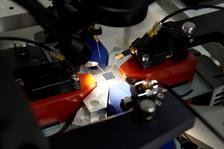Our home-made multi purpose sputter system. The argon plasma is visible in the chamber.
Thin film deposition
We operate several home-made high vacuum sputter deposition systems for thin film preparation. All of them have options for oblique incidence deposition. Heating and cooling options are also available. Using either DC or RF magnetron sputtering, both conducting and insulating materials can be sputtered. Reactive sputtering is also possible. Our smallest sputter chamber is used for in-situ experiments at beamline endstations. The applictions of the chambers range from simple single thin films, over multilayers, to complex thin film systems consisting of up to seven different materials. Due to the design of the chamber we can also coat long X-ray mirrors or perform 3D coatings.
Ion beam etching
A home-made physical etching system with a Kaufman ion source is used for ion beam etching with argon ions or neutral argon atoms. This system is used to structure thin film elements in combination with lithographic techniques.
Magnetometry
MOKE:
Magnetometry based on the magneto-optical Kerr effect is performed with a home-made laser setup. The setup is sensitive to small magnetic changes in ultrathin layers. High bidirectional magnetic fields can be applied.
An optical Kerr microscope is available in the Nanolab for magnetic hysteresis and magnetic domain imaging in micro- and nanostructures.
Magnetoresistance:
A magneto-resistive setup from the group of Guido Meier (MPSD) is used in a collaboration. It can measure high and low resistive samples. This home-made setup can apply two dimensional vector fields to measure complex magnetoresistive responses. The setup is temperature stabilized for high precission resistance measurements.
Magnetization Dynamics:
To study magnetization dynamics we use a home-made microwave absorption spectroscopy setup from the group of Guido Meier (MPSD). Two dimensional vector fields can be applied. The frequency range from DC to 26 GHz allows for broadband spectroscopic measurements. Time domain measurements are also possible down to the picosecond timescale.
Beamline instrumentation
Growth studies:
One of our high vacuum sputter chambers is build for experiments at beamline endstations where thin film or nanostructure growth can be investigated in-situ. Magnetic field, heating and cooling options are available.
RF field excitation:
We have one dedicated setup for the application of high frequency signals to samples at a beamline endstation. The setup has full flexibility of all translational degrees of freedom while maintaining the high frequency signal to the sample. In parallel two dimensional magnetic vector fields can be applied. Full microwave absorption spectra can be taken during X-ray illumination.
Other methods
Various other techniques are available at the DESY campus and are used by us in collaboration with other groups. The most intensively used techniques are X-ray reflectometry, X-ray diffraction, and laser lithography. Other instrumentation can be found at the DESY Nanolab website.
| DESY Nanolab |







